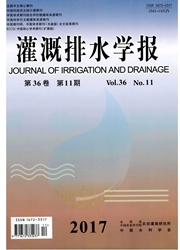

 中文摘要:
中文摘要:
为提高地区农业综合效益的同时节约灌溉用水量,促进地区水资源高效利用,以人民胜利渠灌区为例,在分析计算农作物虚拟水量的基础上,建立了基于虚拟水贸易的灌区种植结构多目标优化模型。结果表明,灌区虚拟水量相对较大的作物为棉花、油菜和水稻,虚拟水量较小的作物为花生、小麦和玉米。通过模型的优化调整,最终优化方案与现有方案相比,水稻和油菜的种植面积均有所减少,而花生的种植面积有所增加。优化后灌区粮食总产量可达6.4亿kg,灌区的粮食安全得以保障。经济效益值增加了1.8亿元,占现状年效益的15.4%;生态效益值增加了1.2亿元,占现状年效益的3.1%;节约灌溉水6 370.7万m3,占现状年用水量的15.6%;节约虚拟水1 659.5万m3,占现状年虚拟水量的2.0%。可见,考虑虚拟水贸易来指导种植结构的调整,在提高灌区综合效益的同时,还促进了灌区水资源的高效利用,缓解了水资源压力,为灌区种植结构调整提供了一种新途径。
 英文摘要:
英文摘要:
Aiming at improving the comprehensive benefits of irrigation agriculture, saving irrigation water and promoting efficient use of water resources, crop planting structure optimization model of People's ShengLi canal irrigation area based on virtual water trade was established. The results showed that in the irrigation area crops with higher virtual water content were cotton, rape and rice, and the ones with lower virtual water content were peanuts, wheat and corn. The final optimization scheme via adjustment and optimization compared with the existing scheme showed better results that the rice and rape planting area declined to some extent, while the wheat and peanut planting area increased. Total grain output of the irrigation area could reach 650 million kilograms after optimizing planting structure, thus the food security in the irrigation area could be ensured. Besides, the economic value increased by 140 million yuan (12.0%), and the ecological economic value also increased by 160 million yuan (4.2%), and 90.079 million cubic meters irrigation water and 50.998 million cubic meters virtual water could be saved at the same time. Under the guidance of virtual water trade, the optimized planting structure could develop the comprehensive benefit of irrigation area, and make efficient use of irrigation water as well as alleviate the pressure of water resource.
 同期刊论文项目
同期刊论文项目
 同项目期刊论文
同项目期刊论文
 期刊信息
期刊信息
